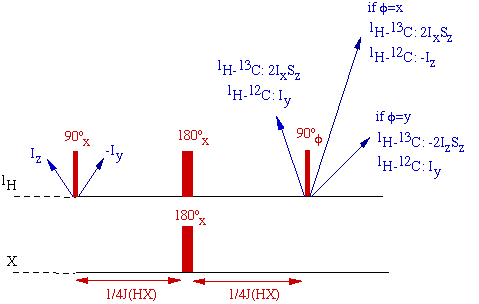|
|
The X-filter element ( 96JB492-8 , 97JACS6711 ) plays an important role in multidimensional NMR experiments specifically designed to study biomolecular complexes, where one of the components, for instance the protein, is usually 13C and/or 15N-labeled and the another, the ligand, is at natural abundance. The X-filter is based in the evolution of J(XH) for 1H-13C systems whereas 1H-12C remains unaltered during an spin echo period. Thus, at the end of this period, 1H-12C is on the y axis whereas 1H-13C is on the x axis. A 90 proton pulse applied from x or y axis rotates only one of these two magnetizations to the z axis, whereas the other component remains in the transverse plane.REQUIREMENTS

The use of this block can be improved using:
This block can be easily inserted in conventional 2D 1H experiments (NOESY, TOCSY ...) replacing the original preparation (w1-filtering/editing) or detection (w2-filtering/editing) schemes. Examples have been reported for:
Easy implementation on AVANCE spectrometers.EXPERIMENTAL DETAILS
The interpulse delay is optimized to 1/(4*1JCH) .SYNTAX
The most standard way to implement a refocused X filter in a pulse program is:in which:
...
p1 ph1
d4
(p2 ph2):f1 (p4 ph3):f2
d4
p1 ph4
...
- d4 is the evolution period optimized to 1/(4*1JXH)
- p1 and p2 are the 90º and 180º 1H pulses (in microseconds) applied at a power level pl1 from the f1 channel.
- p4 is the 180º 13C pulse (in microseconds) applied at a power level pl2 from the f2 channel.
- All phase may be specified at the end of pulse program. In particular, ph4 define the last rotation process.
See Isotope filters.A series of widely used 3D and 4D experiments can result of this approach:
- 3D HMQC-NOESY experiment.
- 3D NOESY-HMQC experiment.
- 3D HMQC-NOESY-HMQC experiment.
- 4D HMQC-NOESY-HMQC experiment.